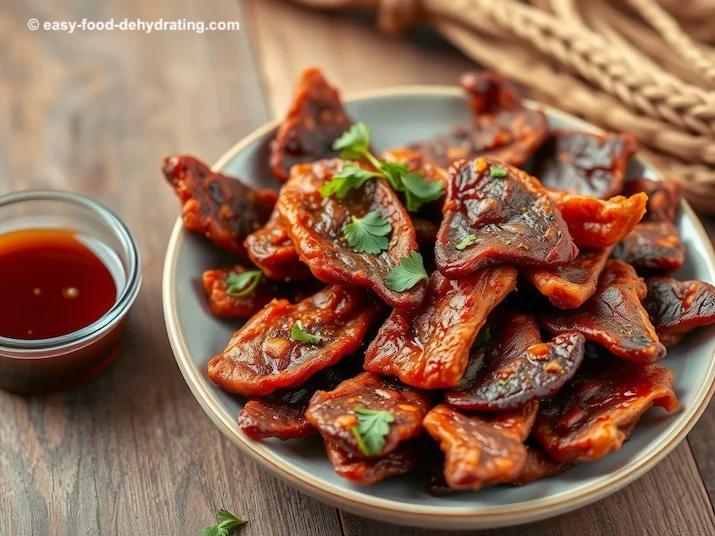What We Mean by “Dehydrate”
Here at Easy Food Dehydrating, “dehydrate” always means using an electric food dehydrator — the easy, reliable way to dry food at home.
- Home
- How to Dehydrate Meat
- How to Dehydrate Chicken (Pre-cooked)
How to Dehydrate Chicken the Safe & Simple Way

Dehydrating chicken is one of the best ways to preserve it for lightweight meals, long-term storage, or trail use. By removing moisture, you stop bacterial growth while keeping nearly all the flavor and protein intact. The result is compact, shelf-stable chicken that rehydrates beautifully for soups, casseroles, and backpacking meals - no refrigeration required.
✅ Quick Answer: How do you dehydrate chicken?
To dehydrate chicken, start with fully cooked meat - never raw*. Slice it thin, lay it on dehydrator trays or a wire rack, and dry at 160°F until crisp. Whether using deli slices, leftovers, or canned chicken, always use safe temps and store in airtight containers with oxygen absorbers.
*If you’re making jerky, the seasonings and marinade you use on the raw chicken act as natural preservatives - helping extend shelf life and enhance flavor. Beyond jerky, dehydrating cooked chicken itself is an excellent preservation method. It removes moisture, reduces weight, and keeps the meat safe for storage or travel while preserving most of its nutrition and taste.
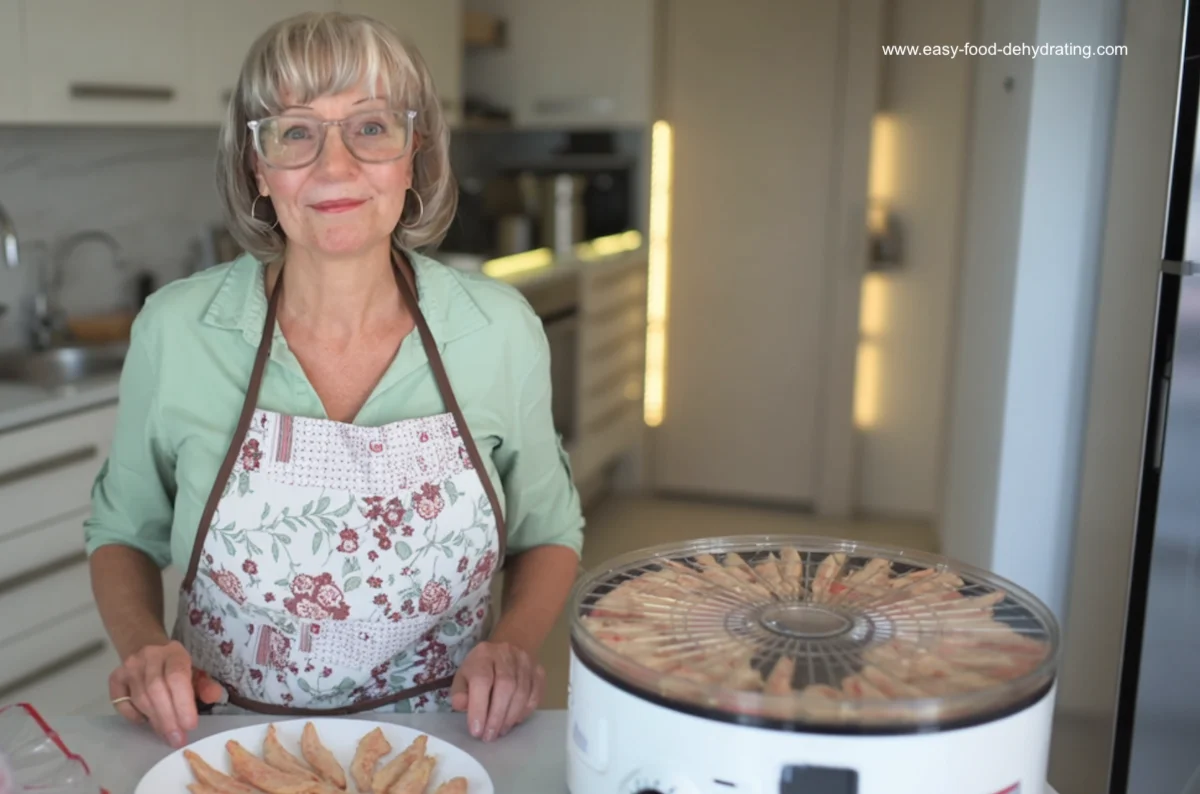
This guide covers everything from pre-cooked deli slices to leftover roast chicken and even canned chicken.
Whether you’re stocking your pantry, prepping for a hike, or planning meals that last, you’ll find methods, tips, and jerky recipe links coming up.
How to Dehydrate Pre-Cooked Chicken Using a Dehydrator
- Prepare the Trays: Arrange pre-cooked, pre-sliced chicken evenly on the dehydrator trays. Ensure slices do not overlap.
- Set the Temperature: Use a setting of 160°F for safe and effective dehydration.
- Monitor and Rotate: Rotate the trays periodically for even drying. While this step may not be in your dehydrator manual, it ensures consistency.
- Check for Crispness: The chicken is fully dehydrated when it feels crisp.
💡 Tip: Outside the U.S.? Most dehydrating temps here are listed in Fahrenheit - use our quick converter to see the Celsius equivalent for your machine.
Store the dehydrated chicken in food vacuum-sealer bags with a 100cc oxygen absorber and a 5g desiccant packet for long-term freshness.
Chicken Before and After Dehydration
 Before Dehydration: Pre-cooked, sliced chicken
Before Dehydration: Pre-cooked, sliced chicken After Dehydration: Crisp, dehydrated chicken
After Dehydration: Crisp, dehydrated chickenHow to Dehydrate Chicken in a Regular Oven
- Preheat the Oven: Set your oven to its lowest temperature, usually around 150°F–170°F.
- Arrange the Chicken: Place chicken slices on a wire rack, ensuring airflow around each piece.
- Keep the Door Slightly Open: Use a wooden spoon to keep the oven door ajar for proper air circulation.
- Monitor Progress: Check the chicken every couple of hours until it reaches your desired crispness.
Important: Only dehydrate cooked chicken, never raw.
How to Dehydrate Leftover Cooked Chicken
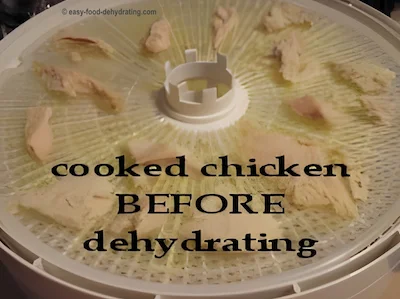 Cooked Chicken before dehydrating
Cooked Chicken before dehydrating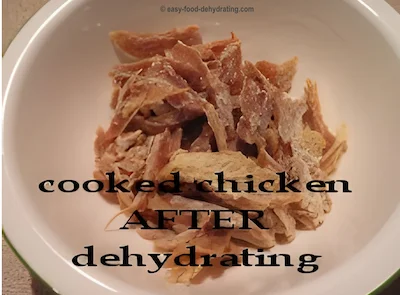 Cooked Chicken after dehydrating
Cooked Chicken after dehydratingTurn Dehydrated Chicken Into Tasty Jerky Snacks
Need a protein-packed snack? Make this homemade chicken jerky! A food dehydrator simplifies the process, letting you create flavorful, chewy jerky anytime.
Skip store-bought snacks and enjoy a healthier alternative. With just a few spices and some marinating, you’ll have a delicious treat perfect for hiking, road trips, or snacking at home.
Easy Chicken Jerky Recipe Links
🐔 Want to turn your dehydrated chicken into something seriously snackable?
Try one of these popular recipes:
👉 Easy Chicken Jerky Recipe
👉 Hot Honey Chicken Jerky Recipe
Why 160°F Is the Safe Zone for Chicken
Always dehydrate chicken at 160°F. Using lower temperatures increases the risk of bacterial growth, making it unsafe to consume.
Don’t Take Chances When Dehydrating Meat
If you’re drying plain, cooked turkey (or any cooked meat), always set your dehydrator to 160°F - it’s the safe zone that kills bacteria like Salmonella and E. coli.
👉 If you’re making jerky from raw meat, it must be properly marinated using salt and/or curing ingredients that help inhibit bacterial growth. The spices and acids act as preservatives - but it still needs to be dehydrated at 160°F.
⚠️ Never try dehydrating raw, unseasoned turkey or ground meat without first cooking it - that’s a serious safety risk.
Don’t Take Chances When Dehydrating Meat
If you’re drying plain, cooked turkey (or any cooked meat), always set your dehydrator to 160°F - it’s the safe zone that kills bacteria like Salmonella and E. coli.
👉 If you’re making jerky from raw meat, it must be properly marinated using salt and/or curing ingredients that help inhibit bacterial growth. The spices and acids act as preservatives - but it still needs to be dehydrated at 160°F.
⚠️ Never try dehydrating raw, unseasoned turkey or ground meat without first cooking it - that’s a serious safety risk.
💡 Tip: Outside the U.S.? Most dehydrating temps here are listed in Fahrenheit - use our quick converter to see the Celsius equivalent for your machine.
How to Rehydrate Chicken for Maximum Flavor
Rehydrated chicken can taste even better with the right technique:
- Soak dehydrated chicken slices in chicken stock (I recommend "Better Than Bouillon") or clean water.
- Let it sit in the refrigerator for about 30 minutes.
- Once rehydrated, the chicken will regain its moisture and tenderness.
This process adds flavor and makes the chicken ready for soups, salads, or other dishes.
 Sliced deli chicken after dehydrating
Sliced deli chicken after dehydrating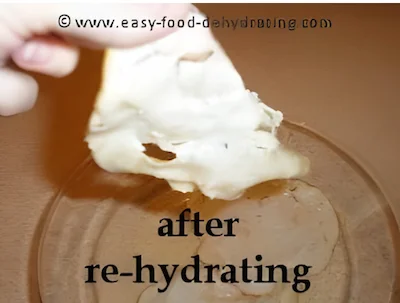 Sliced deli chicken after REhydrating
Sliced deli chicken after REhydratingIn the photos above, you can see just how crispy the chicken was after dehydrating! I then purposely draped a slice of the rehydrated chicken around my finger so you could clearly see that it was moist and floppy again.
Make a small amount of chicken stock (from my favorite Better Than Bouillon) and wow, what a difference it makes to the taste of the rehydrated chicken! Make a note of that! :-)
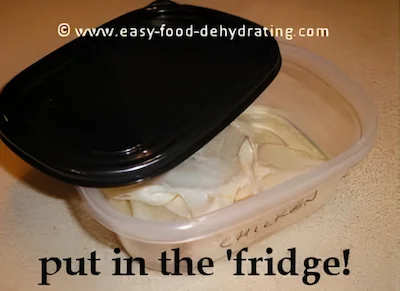 Store in refrigerator while rehydrating
Store in refrigerator while rehydrating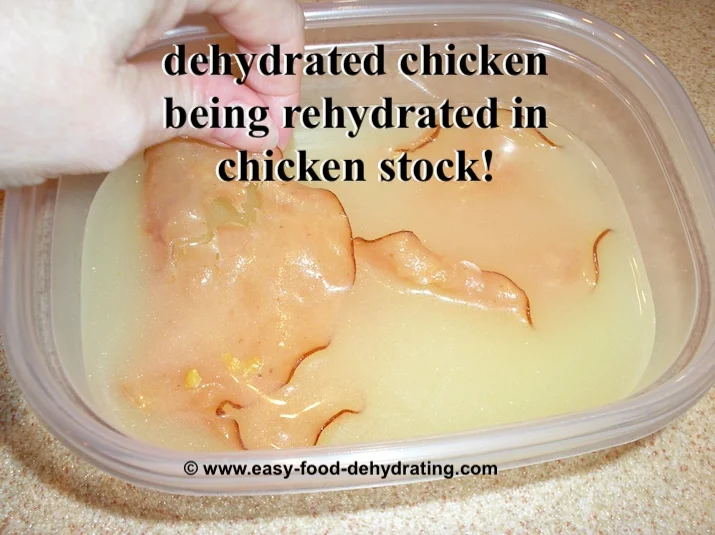 Chicken slices rehydrating in chicken stock
Chicken slices rehydrating in chicken stockCan You Dehydrate Canned Chicken?
Yes - and it’s tasty! For long hikes or convenient meal prep, canned chicken (which is already fully cooked) is an excellent option.
According to Sarah in Australia, canned chicken dehydrates and rehydrates perfectly. She recommends using low-fat varieties to avoid spoilage during storage. This is what she says:
"I do a lot of dehydrating for long hiking trips and have found that the canned chicken (that looks like canned tuna) in the supermarket (yes sounds gross) is the only chicken I've been able to dehydrate that re-hydrates exactly like it was prior. Taste and texture on rehydration is perfect for chicken, just remember to buy the low-fat canned chicken."
NOTE: I have used 'canned chicken' in soups and chicken salad! :-) And yes, the low-fat stops rancidity when storing "long term". Thanks so much for posting!
Best Ways to Store Dehydrated Chicken
Store dehydrated chicken in vacuum-sealed bags or airtight containers. Add oxygen absorbers to prevent spoilage and keep in a cool, dry place.
Can You Dehydrate Pork? Absolutely — Here’s How
This morning I had Robert S. write in to ask if it's OK to dehydrate cooked pork.
Answer: YES... (here's how!)
I also thanked him for bringing it to my attention that I hadn't listed pork alongside the chicken, turkey, and beef! I have now, and here is how to dehydrate pork.
Thanks!
Frequently Asked Questions About Dehydrating Chicken
What's the ideal temperature for dehydrating cooked chicken?
What's the ideal temperature for dehydrating cooked chicken?
Dehydrate cooked chicken at 160°F. Always check your food dehydrator’s manual for specific instructions.
Can you use a regular oven to dehydrate chicken?
Can you use a regular oven to dehydrate chicken?
Yes, you can. Keep reading to learn the oven method.
Can you dehydrate canned chicken?
Can you dehydrate canned chicken?
Yes! Low-fat canned chicken works best as it avoids rancidity during storage.
How long does dehydrated chicken last?
How long does dehydrated chicken last?
Properly dehydrated chicken can last 1–2 months at room temperature when stored in an airtight container in a cool, dark place.
For longer storage (up to a year), seal it in vacuum-sealed bags or airtight Mason jars in the freezer.
Always ensure the chicken was cooked to 165°F (74°C) before dehydrating, and let it to cool completely before sealing to prevent moisture buildup.
When in doubt, check for any off smell or texture changes before rehydrating.
How do you rehydrate dehydrated chicken?
How do you rehydrate dehydrated chicken?
Soak dehydrated chicken in warm water or chicken broth for 20–30 minutes, or until soft. For more flavor, use broth (like Better Than Bouillon) and refrigerate while soaking. Once rehydrated, it’s ready to use in soups, casseroles, salads, or wraps.
If this guide helped you master chicken dehydration, wait until you try some of my favorite meals made with dried ingredients.
From soups like carrot, minestrone, and split pea to spicy beef jerky and even banana cinnamon rolls, these recipes are perfect for long-term storage and real-life flavor. Be sure to grab your free 5 Dried Food Recipes You'll Actually Love PDF below!
Get 5 Dried Food Recipes You'll Actually Love
Here's where you can get your copy of our all new
5 Dried Food Recipes (That Actually Taste Great)
They're my all-time favorite easy dried food meals!
Get it here right now.
For Free!
Before You Go...
If you enjoyed this page, tap the ❤️ in the lower right-hand corner.
It saves this page to your Grow bookmarks so you can find it again later.
You’ll also see quick share buttons to copy the link, post to Facebook,
or save it straight to Pinterest.
